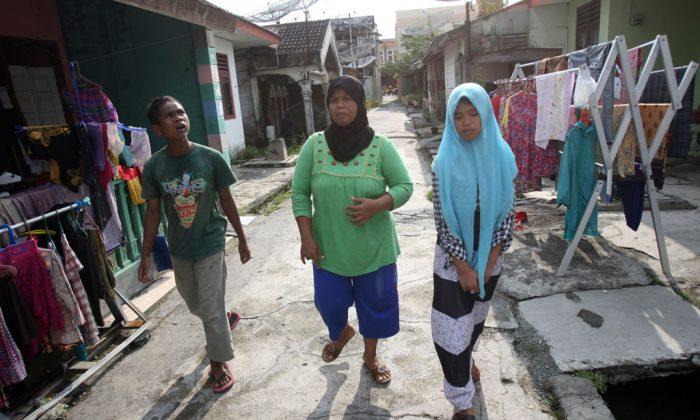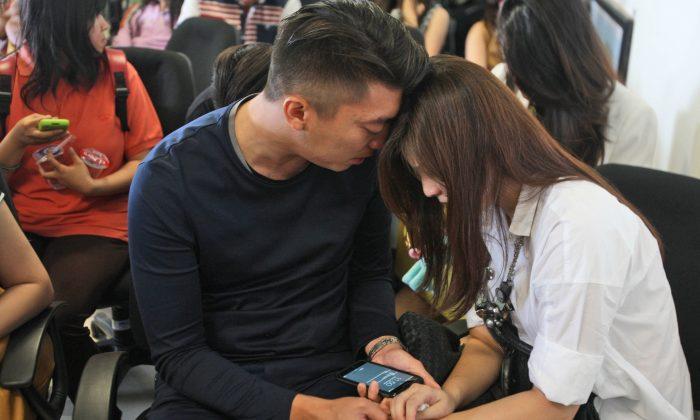MEULABOH, Indonesia—It all started with a dream that led to a chance meeting: A girl who had been swept away by the Indian Ocean tsunami a decade ago.
For three nights, the child’s uncle said she visited him in his sleep. When he told the girl’s mother, Jamaliah, it was hard to believe at first. The daughter was only 4 when a towering wave ripped her away with her 7-year-old brother, clinging to a board.
But the mother had always been convinced both children were still out there and that the family would be reunited. Like most Muslims in this part of Indonesia, she also believed that sometimes God whispers answers to prayers at night.
Soon after the dream, the uncle ran into a 14-year-old orphan girl who had survived the disaster and washed up on a remote island with her older brother. She said they had stayed alive by riding a slab of wood.
The odds were impossible, Jamaliah reminded herself. Too much time had passed. The island was so far away.
But after the uncle sent a photo of the girl, the mother became convinced God was giving their family the second chance longed for by so many parents who had lost children in the disaster.
“I said, ‘I’m sure that’s my daughter,’” she recalled. “I felt the connection in my womb.”
A month later, Jamaliah had the same feeling. This time, after hearing that a 17-year-old homeless boy calling her “mom” had also been found.
But was it real, or all just a dream?
* * *
It was just before 8 a.m. on Dec. 26, 2004. The sky was blue, and Jamaliah, who uses only one name, was hanging clothes on the line while her three kids were inside watching TV on a sleepy Sunday.
In a second, everything changed.
The earth shook so hard, Jamaliah thought it would never stop. Her husband, Septi Rangkuti, and the children ran outside to the street where their little concrete row house sat about 500 meters (550 yards) from the sea. After minutes of violent rumbling, they were stunned and confused by the sheer power of the 9.1-magnitude quake.
Jamaliah then heard people screaming: “The water is coming! The water is coming!”
The family of five leaped onto their motorbike and made it as far as the market, but they couldn’t outrun the wall of black water.
Jamaliah and her 8-year-old son were pulled away by the wave. As they somersaulted in the darkness, the mother was somehow able to hold onto his hand while grabbing onto a pole.
Rangkuti managed to keep hold of his 7-year-old son and 4-year-old daughter long enough to put them on top of a large floating board. He held on as long as he could, but when the water sucked back to the sea, his fingers slipped. The last thing he remembers is his two little ones being dragged away from him by the angry torrent.
Hours later, Jamaliah and their oldest son found Rangkuti wandering on a street. His clothes were ripped, and he was bleeding.
One look at his empty eyes, and she knew the kids were gone.

* * *
The calamity was so vast, it remains hard for those who survived to understand. One of the largest earthquakes ever recorded forced the Indian Ocean to heave gigantic waves at jetliner speeds into Indonesia’s westernmost coast. Some 230,000 people in 14 countries were killed, with Aceh province logging nearly three-quarters of the deaths. Around 37,000 bodies were never recovered and presumed swept out to sea — the majority women and children.
With no bodies to bury, many parents have struggled to let go. Most of the 1,500 children found after the disaster were returned to their families or taken in by neighbors or friends, though some ended up in orphanages, said Bukhari, who uses one name and heads the Aceh provincial Social Affairs Office, which ran a program to reunite families. It ended in 2006, but news of a few other miraculous meetings over the years left some parents wondering if their own kids might still be alive.
“The uncertainty of what happened to those children, the desperate hope that maybe they did survive somehow, that irresistible idea that they might be reunited, what parent wouldn’t think about that?” said Harry Minas, a mental health expert from the University of Melbourne who has worked in Aceh since the tsunami. “The grief with that sort of loss can be perpetual.”
Jamaliah and Rangkuti spent a month and a half searching for their son, Arif Pratama, and their daughter, Raudhatul Jannah. They scoured areas around their home and traveled for hours on washed-out roads up a chewed-up coast tangled by debris. Their home and the entire street were gone — there was nothing for the kids to come back to even if they had survived.
Rangkuti was so withdrawn and traumatized he wouldn’t go near the sea or even look at water in the river. They had lost everything, and with no money and a surviving son to look after, they decided to stay with relatives several hours away in North Sumatra.
Time passed, and the family settled in and tried to move on. Jamaliah had a baby boy two years after the tsunami, and Rangkuti finally started to let go of the grief and guilt that had locked him into a deep depression. But neither gave up hope they would one day find their lost children.
“I believed it in my heart,” Jamaliah said. “I prayed every night because of the strong emotional connection to my kids. I believed we would be together again.”
* * *
This summer, Jamaliah’s older brother, Zainuddin, called with stunning news. He'd had a dream three nights in a row about a girl in Banda Aceh whose headscarf fell away from her hair.
At first he thought it must be his own daughter. But the morning after the third night, he visited a cafe not far from his house and was shocked to see a face that looked just like the one from his dreams.
“The way she shook her head, gazed and smiled, it was all identical with the girl in my dream,” he said, adding that he was convinced she looked just like a younger version of Jamaliah.
The shop owner, Rosmani, told him the girl was a tsunami orphan taken in by close friends of hers. Zainuddin said he later talked to the foster family and discovered that after the disaster, a fisherman found her and a boy on the sparsely populated Banyak islands, about six and a half hours by car and boat from Jamaliah’s house in Meulaboh.
The girl had little memory of life before the tsunami.
“I remember when we were on the board. I was there with my brother,” she said. “I was found by someone on the beach and taken to a house. That’s where we were split. Someone took me and someone took my brother.”
In July, Jamaliah and Rangkuti traveled around 100 kilometers (60 miles) by bus to meet the girl, who went by the name Weniati. At first sight, the mother said it was hard to tell if she was really her child — so much time had passed.
Since the tsunami, the girl had lived with three different relatives in one foster family and was now located in South Aceh. They were poor, but had kept her clothed and fed. She had not attended school regularly and only had a fourth-grade education, and she collected neighbors’ laundry to help the family make ends meet.
Jamaliah asked to take her back to Meulaboh, where they had lived when the tsunami hit, to celebrate the end of Ramadan. The desperate mother said she prayed for a sign that the girl would remember something from her childhood.
But so much had changed in Meulaboh, a small town about five hours from Banda Aceh along the so-called “Clinton Highway,” a coastal road built with U.S. funding. Landmarks and houses the girl might have remembered have been largely replaced by buildings financed by billions of dollars in international aid. Only a few reminders of the tsunami remain, including the skeletons of windowless buildings at the beach, now tattooed in graffiti, and the occasional brick foundation jutting out of the sea.
But one important place escaped the tsunami: A house that belonged to Jamaliah’s mother. When the girl saw it, memories of eating sweet tropical fruit came back.
“She remembered the chicken coop and the rambutan tree,” Jamaliah said, smiling. “She remembered waiting for durian that her grandmother used to give her.”
This was all the sign she needed.

* * *
Jamaliah and Rangkuti returned the girl to her village as promised, but wanted to bring her home with them for good to Meulaboh. She said the foster family was hesitant and asked for a DNA test and documentation proving that she was really their child. The parents agreed, but said they had no money for to pay for it.
Sarwani, the foster grandmother who last cared for the girl, said she later agreed to let her go.
“It turned out that Weniati herself is confident that Jamaliah is her mother and Rangkuti is her father,” she said. “What can I say? I don’t want to impede the reunion of a daughter and her mother.”
In the meantime, Indonesian media heard about the story and soon Jamaliah was on national television with the girl she was calling her daughter. Every time Jamaliah spoke about the miraculous reunion, tears dripped onto her headscarf as she recalled her years of agony.
The TV exposure caught the attention of Lana Bestir, a woman in West Sumatra who had been feeding a homeless boy for years after he turned up at her Internet cafe.
When a photo of the young brother and sister taken before the tsunami flashed on the screen, she was shocked. It looked similar to the boy she knew as Ucok. She said she then showed him a picture of Jamaliah from the Internet, without giving him any information about her.
“This is my mother. Yes, this is my mother, Liah!” Bestir recalled the boy saying after he stared at the photo. “I want to meet her. Where can I meet her?”
When she got the call, Jamaliah, whose nickname is Liah, wondered: Could a second miracle really be possible? She went to the boy immediately, but he was also hard to identify.
He was much darker than Arif had been. She reasoned perhaps it was from foraging for years in the sun and sleeping outside. His forehead also bore a melted scar that ran so deep, it was bone white.
Arif had been a top student, but this boy did not know his name and could hardly speak any distinguishable language. He also had the mentality of a young child.
Bestir said he recalled “flying” on “big, dark water” with his sister. He remembered washing up on a beach and being taken to live with a family, but he doesn’t know where. He said that one day, when he stayed in bed too long, a woman in the house threw scalding coffee in his face. After that, the street became his home.
“I was sad at first,” Jamaliah recalled, adding she knew it was him when she recognized a scar on his nose from childhood. “But then I said, ‘Whatever happened to my son, I’ve been waiting so long, I can be patient and take care of him now.’”
* * *
Inside the tiny row house on the same street where they were ripped apart, the family sits together again on the floor.
The girl, impossibly shy, is in the corner taking selfies with a pink phone. Her brother smirks at her while folding pieces of paper that pop like firecrackers when he flicks them.
Rangkuti tells his wife to leave Raudhatul and Arif alone when they yell and fight. He likes hearing the sound of children’s voices in the house again.
It hasn’t been easy since they moved in. At first, Arif kept going to the neighbors, begging for money and food. Jamaliah suspects he may still be traumatized. Many children who survived the tsunami were confused and suffered mental health issues, including some who were unable to talk or remember their own names.
A doctor told her nothing serious is wrong, but he needs a lot of attention. He’s now speaking fluently, and she plans to send him to a religious boarding school to help instill discipline and give him a basic education.
She also wants to get the girl caught up to her grade. She said there’s still some wrangling with members of the foster family who are less supportive, but they have agreed to let her stay for now. Repeated calls and texts by The Associated Press seeking comment from them were not returned.
After the children were interviewed by police, the village head signed a document saying they belong to Jamaliah and Rangkuti.
“I don’t want to go back,” Raudhatul said, softly. “I’m happier here because I’m with my real family.”
As the boy and girl run down the street, old neighbors who remember the children from before the tsunami say they believe God has led them home. Almost everyone here lost someone, and the pain still runs deep.
“She’s so lucky that she got to start over,” said Yuswarni, a neighbor who sobbed while recounting the loss of her entire family. “I just have to be patient with the life I have to live.”
Jamaliah said one woman moved off the street, arguing it wasn’t fair that their family got a second chance. She said some people also question whether their story is true, but none of that matters to them.
The family recently moved back to North Sumatra near Rangkuti’s family where it’s easier for him to find work and for the children to settle into new schools.
To Minas, the mental health expert, bloodlines aren’t what matter — especially since a boy who lacked a home now has one.
“If they genuinely believe that these are their children, then that’s a family,” he said. “If the children also accept it, that is a family.”
Jamaliah said even if a DNA test came back negative, it would never stop a mother’s love.
“It feels like a reborn family,” she said, smiling. “I sometimes feel like it’s a dream. Is it real or not? But then I just trust in God and believe that this is my family.”
From The Associated Press. AP writers Niniek Karmini in Jakarta and Fakhrurradzie Gade in Banda Aceh contributed to this report.





Friends Read Free